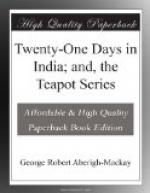I cannot understand why Viceroys and English newspapers call the Indian cultivator a “riot.” He never amounts to a riot if you treat him properly. He may be a disorderly crowd sometimes; but that is only when you embody him in a police force or convert him into cavalry. The atomic disembodied villager has no notion of rioting, ca-ira singing, or any of the tomfooleries of revolution. These pastimes are for men who are both idle and frivolous. When our villager wants to realise a political idea, he dies of famine. This has about it a certain air of seriousness. A man will not die of famine unless he be in earnest.
Lord Bacon’s apothegm was that Eating maketh a full man; and it would be better to give the starving cultivator Bacon than the report of that Commission (which we cannot name without tears and laughter) which goes to work on the assumption that writing maketh a full man—that to write over a certain area of paper will fill the collapsed cuticles of the agricultural class throughout India.
When [Sir Richard Temple] first started the idea of holding famines, I proposed that he should illustrate his project by stopping the pay and allowances of the Government of India for a month. But he did not listen to my proposal. People seldom listen to my proposals; and sometimes I think that this accounts for my constitutional melancholy.
You will ask, “What has all this talk of food and famine to do with the villager?” I reply, “Everything.” Famine is the horizon of the Indian villager; insufficient food is the foreground. And this is the more extraordinary since the villager is surrounded by a dreamland of plenty. Everywhere you see fields flooded deep with millet and wheat. The village and its old trees have to climb on to a knoll to keep their feet out of the glorious poppy and the luscious sugar-cane. Sumptuous cream-coloured bullocks move sleepily about with an air of luxurious sloth; and sleek Brahmans utter their lazy prayers while bathing languidly in the water and sunshine of the tank. Even the buffaloes have nothing to do but float the livelong day deeply immersed in the bulrushes. Everything is steeped in repose. The bees murmur their idylls among the flowers; the doves moan their amorous complaints from the shady leafage of pipal trees; out of the cool recesses of wells the idle cooing of the pigeons ascends into the summer-laden air; the rainbow-fed chameleon slumbers on the branch; the enamelled beetle on the leaf; the little fish in the sparkling depths below; the radiant kingfisher, tremulous as sunlight, in mid-air; and the peacock, with furled glories, on the temple tower of the silent gods. Amid this easeful and luscious splendour the villager labours and starves.
Reams of hiccoughing platitudes lodged in the pigeon-holes of the Home Office by all the gentlemen clerks and gentlemen farmers of the world cannot mend this. While the Indian villager has to maintain the glorious phantasmagoria of an imperial policy, while he has to support legions of scarlet soldiers, golden chuprassies, purple politicals, and green commissions, he must remain the hunger-stricken, overdriven phantom he is.




